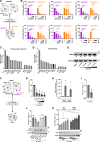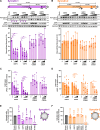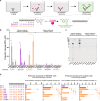Inhibition of placental trophoblast fusion by guanylate-binding protein 5
- PMID: 40333975
- PMCID: PMC12057675
- DOI: 10.1126/sciadv.adt5388
Inhibition of placental trophoblast fusion by guanylate-binding protein 5
Abstract
Syncytin-1 and Syncytin-2 are envelope glycoproteins encoded by human endogenous retroviruses that have been exapted for the fusion of cytotrophoblast cells into syncytiotrophoblasts during placental development. Pregnancy complications like preeclampsia are associated with altered expression of interferon-stimulated genes, including guanylate-binding protein 5 (GBP5). Here, we show that misdirected antiviral activity of GBP5 impairs processing and activation of Syncytin-1. In contrast, the proteolytic activation of Syncytin-2 is not affected by GBP5, and its fusogenic activity is only modestly reduced. Mechanistic analyses revealed that Syncytin-1 is mainly cleaved by the GBP5 target furin, whereas Syncytin-2 is also efficiently processed by the proprotein convertase subtilisin/kexin type 7 (PCSK7) and thus resistant to GBP5-mediated restriction. Mutational analyses mapped PCSK7 processing of Syncytin-2 to a leucine residue upstream of the polybasic cleavage site. In summary, we identified an innate immune mechanism that impairs the activity of a co-opted endogenous retroviral envelope protein during pregnancy and may potentially contribute to the pathogenesis of pregnancy disorders.
Figures




References
-
- Johnson W. E., Origins and evolutionary consequences of ancient endogenous retroviruses. Nat. Rev. Microbiol. 17, 355–370 (2019). - PubMed
-
- Imakawa K., Nakagawa S., Miyazawa T., Baton pass hypothesis: Successive incorporation of unconserved endogenous retroviral genes for placentation during mammalian evolution. Genes Cells 20, 771–788 (2015). - PubMed
-
- Blond J. L., Lavillette D., Cheynet V., Bouton O., Oriol G., Chapel-Fernandes S., Mandrand B., Mallet F., Cosset F. L., An envelope glycoprotein of the human endogenous retrovirus HERV-W is expressed in the human placenta and fuses cells expressing the type D mammalian retrovirus receptor. J. Virol. 74, 3321–3329 (2000). - PMC - PubMed
-
- Chen C.-P., Chen L.-F., Yang S.-R., Chen C.-Y., Ko C.-C., Chang G.-D., Chen H., Functional characterization of the human placental fusogenic membrane protein syncytin 2. Biol. Reprod. 79, 815–823 (2008). - PubMed
MeSH terms
Substances
LinkOut - more resources
Full Text Sources

